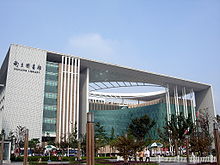- Nanjing Library
-
Nanjing Library (Simplified Chinese: 南京图书馆 Pinyin: Nánjīng Túshūguǎn) is the third largest library in China with over 7 million items. It houses important scientific, cultural and arts literature relating to Jiangsu province and other national historical records such as ancient Chinese and foreign publications. The library contains 1.6 million ancient books and 100,000 volumes of books (including Buddhist scriptures) dated from the Tang Dynasty to the Ming Dynasty.[1]
Contents
History
Nanjing Library was established in 1907 as Jiangnan Library. Over time, the library has undergone several organisational changes. The Library endured through Chinese feudal dynasties, Chinese democratic revolution, and the founding of new China. It witnessed greatest changes that took place in modern China and by itself gives clear records to the one-century history of modern China.
Jiangnan Library
In 1907 Duan Fang — governor of Liangjiang area — established Jiangnan Library on the site of Xiyin Academy at Nanjing in order to preserve ancient books and scrolls of Song Dynasty, Yuan Dynasty, Ming Dynasty, and Qing Dynasty. Miao Quansun was appointed to be the librarian. The Jiangnan Library turned to be the first library in China.[2]
Library of Chinese Studies, National Central University
In 1927, the University District System was adopted in Zhejiang and Jiangsu Provinces. According to the system, Jiangnan Library was to be administered by the Zhongshan University and named Library of Chinese Studies, Zhongshan University. By the May of 1928, it was renamed as Library of Chinese Studies, National Central University. Liu Yizheng, was appointed to be the chief librarian.[2]
Jiangsu Provincial Library of Chinese Studies
In October 1929, the University District System was abolished, the library was administered by the Jiangsu Department of Education and was renamed as Jiangsu Provincial Library of Chinese Studies.[2]
National Central Library
In 1933, the China Ministry of Education built the National Central Library on Chengxian Street in Nanjing. The Library was relocated several times due to the Sino-Japanese War and the Chinese Civil War. Jiang Fucong was the chief librarian. Towards the end of 1948, Jiang Fucong took about 130,000 volumes of rare books to Taiwan under instructions of Republic of China. In May 1949, the library was handed over to the Nanjing Military Control Commission.[2]
National Nanjing Library
On March 19, 1950, National Central Library was renamed as National Nanjing Library by the Ministry of Culture, and was put under the joint administration of the Bureau of Cultural Relics and Ministry of Culture. He Changqun was appointed as chief librarian. In October 1952, National Nanjing Library merged with Jiangsu Provincial Library of Chinese Studies.[2]
Nanjing Library
In 1954, the Ministry of Culture renamed the National Nanjing Library to Nanjing Library in July 1954 and was supervised by the Jiangsu Provincial Department of Culture. Wang Changbing was appointed as chief librarian.
Departmental structure
The Nanjing Library is organized in the following structure.[3]
- Office of the Chinese Communist Party Committee of NL
- Chief Librarian’s Office
- Human Resources Department
- Labor Union
- Office of General Affairs
- Security Office
- Department of Acquisition and Cataloging
- Reader Service Department
- Department of Information Resources Development
- Department of Information Technology Application
- Historical Archive Department
- Research and Training Department
- Editing House of 21st Century Library
Reciprocal library exchange program
Nanjing Library has partnered with the State Library of Victoria (Australia) for reciprocal exchange since 1985. This includes staff visits and exchange of publications between the libraries.[4]
Location
The Nanjing Library is located at[5] Main Library 66 Chengxian Road, Nanjing, Jiangsu Province 210018, People’s Republic of China
See also
- Shanghai Library
- Libraries in the People's Republic of China
- Chinese Library Classification (CLC)
- Archives in the People's Republic of China
References
- ^ http://www.jslib.org.cn/njlib_Englishversion/njlib_about/njlib_new/default.htm About the Nanjing Library
- ^ a b c d e f "Nanjing Library - About Us - History". About Us. Nanjing Library. 2009. http://www.jslib.org.cn/njlib_Englishversion/njlib_about/njlib_history/. Retrieved 2009-01-04.
- ^ http://www.jslib.org.cn/njlib_Englishversion/njlib_about/njlib_departments/
- ^ http://www.slv.vic.gov.au/about/partners/partnerships/nanjing.html Partnership with the Nanjing Library
- ^ http://www.jslib.org.cn/njlib_Englishversion/njlib_about/njlib_locations/default.htm
External links
Categories:- Buildings and structures in Nanjing
- Libraries in China
Wikimedia Foundation. 2010.

